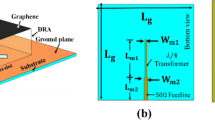Abstract
Polarimetry is an important trend in the development of modern radar. The technique for measuring polarization scattering property of the target is the key for polarization radar realization, but it faces challenges in engineering. Here, a new theoretical model for target scattering characteristic measurement radar, named orthogonal polarization binary array radar (OPBAR), is proposed. The spatial polarization characteristics of the radar antennas are addressed. A new polarimetric algorithm that needs only one channel is designed. The polarization scattering matrix measurement can be implemented by processing received signal in a short time interval while antenna’s beam mechanically scans the target. Through compactness field microwave dark room experiment, measurments of dynamic broadband polarimetry on OPBAR have been conducted and the validity of research work has been demonstrated. The result is helpful to exploiting the capability of current radar systems and enhancing their information acquiring and processing capacity.
Similar content being viewed by others
References
Melanie T, Ramata M, Hardy B G. Application of target decomposition theorems over snow-covered forested areas. IEEE Trans Geosci Remote Sens, 2009, 42: 508–511
Howard S D, Calderban A R, Moran W. A simple signal processing architecture for instantaneous radar polarimetry. IEEE Trans Inf Theory, 2007, 53: 1282–1289
López-M C, Pottier E, Cloude S R. Statistical assessment of eigenvector-based target decomposition therems in radar polarimetry. IEEE Trans Geosci Remote Sens, 2005, 43: 2058–2073
Migliaccio M, Gambardella A. SAR polarimetry to observe oil spills. IEEE Trans Geosci Remote Sens, 2007, 45: 506–511
Martorella M, Palmer J. Polarimetric ISAR auto focusing. IET Signal Process, 2008, 2: 312–324
Wang X S, Dai D H, Xu Z H. Polarization filter performance evaluation and selection. Prog Nat Sci, 2004, 14: 442–448
Wang X S, Chang Y L, Dai D H, et al. Band characteristics of SINR polarization filter. IEEE Trans Antennas Propag, 2007, 55: 1148–1154
Shi L F, Wang X S, Xiao S P. The best sub-step polarization estimation method of radar in the jamming background. Prog Nat Sci, 2005, 15: 1324–1329
Dai D H, Wang X S, Xiao S P, et al. Mathematical principle and characteristics of polarization transform. Sci China Ser G-Phys Sci, 2008, 51: 1287–1299
Dai D H, Wang X S, Xiao S P. Super-resolution polarimetric ISAR imaging based on based on two-dimensional CP-GTD model. Prog Nat Sci, 2007, 17: 1439–1448
Chang Y L, Wang X S, Li Y Z, et al. The signal selection and processing method for polarization measurement radar. Sci China Ser F-Inf Sci, 2009, 52: 1715–1951
Shi L F, Wang X S, Xiao S P. Polarization discrimination between repeater false-target and radar target. Sci China Ser F-Inf Sci, 2009, 52: 149–158
Boerner W M. Recent advances in extra-wide-band polarimetry, interferometry and polarimetric interferometry in synthetic aperture remote sensing and its applications. Radar, Sonar and Navigation. IEE Proc, 2003, 150: 113–124
Chen T J, Chu T H. Calibration and measurement of a wideband six-port polarimetric measurement system. IEEE Trans AP, 1997, 45: 1080–1085
Schwerdt M, Hounam D, Peres J L A. The calibration concept of terra SAR-X: A multiple mode, High-resolution SAR. Can J Remote Sens, 2005, 31: 30–36
Freeman A, Saatchi S S. On the detection of Faraday rotation in linearly polarized L-Band SAR backscatter signatures. IEEE Trans Geosci Remote Sens, 2004, 42: 1607–1616
Mott H. Polarization in Antennas and Radar. New York: John Willey and Sons, Inc., 1986
Wang X S, Li Y Z, Dai D H, et al. Instantaneous polarization statistics of electromagnetic waves. Sci China Ser E-Tech Sci, 2004, 47: 623–634
Luo J, Wang X S, Li Y Z, et al. A new method of radar target polarization scattering matrix measurement. Signal Process, 2009, 25: 868–873
Author information
Authors and Affiliations
Corresponding author
Rights and permissions
About this article
Cite this article
Dai, H., Wang, X., Li, Y. et al. Spatial polarization characteristics and scattering matrix measurement of orthogonal polarization binary array radar. Sci. China Inf. Sci. 53, 2687–2695 (2010). https://doi.org/10.1007/s11432-010-4107-5
Received:
Accepted:
Published:
Issue Date:
DOI: https://doi.org/10.1007/s11432-010-4107-5




